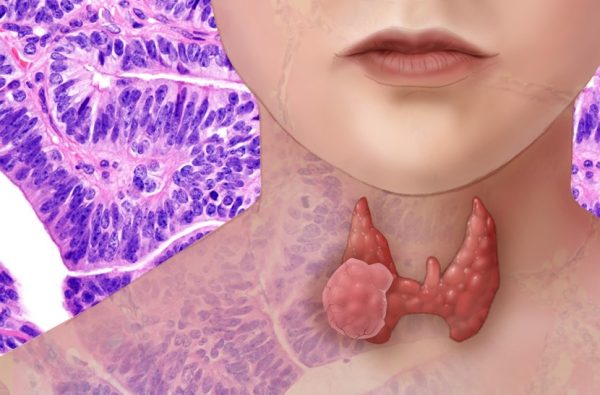
January is Thyroid Awareness Month
January is Thyroid awareness month and it is important to understand the symptoms and conditions associated with thyroid.
What is thyroid? The thyroid gland is a butterfly-shaped endocrine gland that is normally located in the lower front of the neck. It produces thyroid hormones, which are secreted into the blood and then carried to every tissue in the body. Thyroid hormone helps the body to use energy, stay warm and keep the brain, heart, muscles, and other organs working as they should. Both men and women will be at risk if the hormones are not secreted properly the way they should be. Some of the conditions associated with thyroids are listed below:
Iodine deficiency & thyroid: Iodine is an element that is needed for the production of thyroid hormone. The body does not make iodine, so it is an essential part of your diet. Iodine is found in various foods. If you do not have enough iodine in your body, you cannot make enough thyroid hormone. Thus, iodine deficiency can lead to enlargement of the thyroid, hypothyroidism and to mental retardation in infants and children whose mothers were iodine deficient during pregnancy.
Thyroid and body weight: It has been appreciated for a very long time that there is a complex relationship between thyroid disease, body weight and metabolism. Measurement of the Basal Metabolic Rate (BMR) was one of the earliest tests used to assess a patient’s thyroid status. Patients whose thyroid glands were not working were found to have low BMRs, and those with overactive thyroid glands had high BMRs. Later studies linked these observations with measurements of thyroid hormone levels and showed that low thyroid hormone levels were associated with low BMRs and high thyroid hormone levels were associated with BMRs.
Thyroid cancer: Thyroid cancer is rare compared to other cancers. Fewer than 2000 patients die of thyroid cancer each year. In 2008 when statistics were last collected, over 450,000 patients were alive and living with thyroid cancer. Thyroid cancer is usually very treatable and is often cured with surgery and, if indicated, radioactive iodine. Even when thyroid cancer is more advanced, effective and well-tolerated treatment is available for the most common forms of thyroid cancer.
Grave’s disease: Graves’ disease is caused by a generalized over activity of the entire thyroid gland (hyperthyroidism). Symptoms of Grave’s disease include: Hyperthyroidism, eye disease (inflammation, swelling, bulging of eyes, irritation) and skin disease – patients with Graves’ disease develop a lumpy reddish thickening of the skin in front of the shins known as pretibial myxedema. This skin condition is usually painless and relatively mild, but can be painful.
Thyroid nodules: The term thyroid nodule refers to an abnormal growth of thyroid cells that forms a lump within the thyroid gland. Although the vast majority of thyroid nodules are benign (noncancerous), a small proportion of thyroid nodules do contain thyroid cancer. In order to diagnose and treat thyroid cancer at the earliest stage, most thyroid nodules need some type of evaluation.
Goiter: The term “goiter” simply refers to the abnormal enlargement of the thyroid gland. It is important to know that the presence of a goiter does not necessarily mean that the thyroid gland is malfunctioning. A goiter can occur in a gland that is producing too much hormone (hyperthyroidism), too little hormone (hypothyroidism), or the correct amount of hormone (euthyroidism). A goiter indicates there is a condition present which is causing the thyroid to grow abnormally.
Reproductive system & thyroid: Women with hypothyroidism often have menstrual cycle irregularities, ranging from absent or infrequent periods to very frequent and heavy periods. The menstrual irregularities can make it difficult to become pregnant, and pregnant women with hypothyroidism have an increased risk for miscarriage during early pregnancy.
How to Perform a Thyroid Neck Self-Exam to test thyroid:
- Use a mirror and focus on the lower middle area of your neck, above the collarbones, and below the Adam’s apple (larynx). Your thyroid gland is located in this area of your neck.
- While focusing on this area in the mirror, tip your head back.
- Take a drink of water and swallow. As you swallow, look at your neck. Check for any bulges or protrusions in this area when you swallow. Reminder: Do not confuse the Adam’s apple with the thyroid gland. The thyroid gland is located further down on your neck, closer to the collarbone. You may want to repeat this process several times.
- If you do see any bulges or protrusions in this area, see your physician. You may have an enlarged thyroid gland or a thyroid nodule and should be checked to determine whether cancer is present or if treatment for thyroid disease is needed.
For more information on thyroid and its condition, please visit -American Thyroid association websites -http://www.thyroid.org/thyroid-information/ or http://www.thyroid.org/
Image credit: https://commons.wikimedia.org/wiki/File:Thyroid_Cancer_(26990475791).jpg
Attribution: National Human Genome Research Institute (NHGRI) from Bethesda, MD, USA / CC BY (https://creativecommons.org/licenses/by/2.0)
Author: Sumana Rao | Posted on: January 19, 2016
« This Year Vegetables are taking Preferences In our Plate Fiber Rich diet can help to Reduce Risk of lung diseases »






















Write a comment